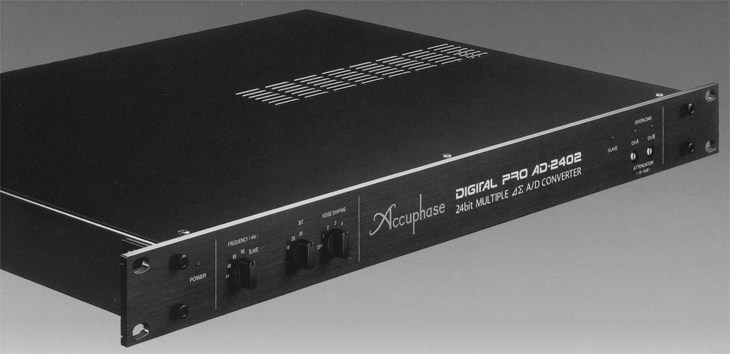
Accuphase AD-2402
¥ 900,000 (released in December 1998)
Commentary
Business A/D converter supporting 96kHz/24bit.
The A/D converter uses the newly developed MDS (Multiple Delta-Sigma) system originally developed by AccuPhase.
In this system, a number of ⊿∑ type A/D converters are connected in parallel. The same analog signal is input to each A/D converter, and the outputs of each A/D converter are added to obtain the overall output. This greatly improves various characteristics.
The ⊿∑ A/D converter is an A/D conversion method that uses oversampling and noise shaping to expand the amplitude information of the input analog signal in the time axis direction to obtain conversion accuracy. However, in the actual A/D conversion output, harmonic distortion and noise, which are conversion errors, are added to the signal conversion output. The signal component of the MDS output is n times the output of each A/D converter, and the conversion error is root n times the conversion error of each A/D converter by statistical calculation. Since the conversion error is 1 / √ n, various characteristics such as S/N, dynamic range, linearity, and harmonic distortion can be improved.
In the AD 2402, four ⊿∑ A/D converters are operated in parallel, and the overall performance is 2 (= √ 4) times higher than that of a single converter.
Small signal linearity exceeding 23 bits has been realized.
64/128 times oversampling method is adopted.
Equipped with an ultra-high precision linear phase type decimation filter.
Noise caused by interference between circuits is eliminated by completely electrically separating the analog and digital sections.
Four sampling frequencies of 44.1k/48k/88.2k/96kHz are available.
In addition, 3 types of output bit number of 16 bit, 20 bit and 24 bit are supported.
Four types of noise shaping can be applied to the output data.
DSP (Digital Signal Processor) realizes ultra-high precision overload detection.
External synchronization is possible.
Synchronous signal input and sampling frequency are automatically detected during external synchronous operation.
Three output formats are supported : AES/EBU, SPDIF, and SDIF2.
Model Rating
| Type | A/D converter |
| Total Harmonic Distortion Factor + Noise (24 bit output, 1 kHz, 0 dBFS : full scale) | -1dBFS input : -102dBmax -10dBFS input : -94dBmax -20dBFS input : -88dBmax |
| Frequency characteristic | 20 Hz to 20 kHz + 0 -0.2 dB (fs = 44.1kHz/48kHz) 20 Hz ~ 40 kHz + 0 -0.2 dB (fs = 88.2kHz/96kHz) |
| S/N ratio (Nyquist band : band with sampling frequency of 1/2) | 108 dB min (within the Nyquist band) 116 dB min (acoustic compensation) |
| Channel separation | 120 dB min (20 Hz to 20 kHz, fs = 44.1kHz/48kHz) 120 dB min (20 Hz to 40 kHz, fs = 88.2kHz/96kHz) |
| Sampling frequency | 44.1kHz/48.0kHz/88.2kHz/96kHz |
| Analog Input (0 dBU = 0.775 v) | Full Scale Level 13 + / - 0.2 dBU (ATT = 0 dB) 19 + / - 0.2 dBU (ATT = -6dB) XLR connector : #2 hot |
| Input impedance | Analog input 20k Ω (between positive phase input and negative phase input) 10k Ω (between positive-phase input / negative-phase input and GND) AES/EBU : 240 Ω SDIF2 : 75 Ω (word clock) |
| Output impedance | AES/EBU : 110 Ω SPDIF : 75 Ω SDIF2 : <5 Ω |
| Number of output bits | Number of bits : 16/20/24bit (switchable) |
| Noise shaping | OFF/1/2/3/4 |
| Operating temperature | Ambient Temperature : 0 to + 40 ° C |
| Power supply voltage | 100 VAC, 50Hz/60Hz |
| Power consumption | 25W |
| Maximum external dimensions | Width 482.5x Height 47x Depth 370 mm (Whole, Including Legs) 1U |
| Weight | 5.5kg |
.jpg)
.jpg)
.jpg)
.jpg)